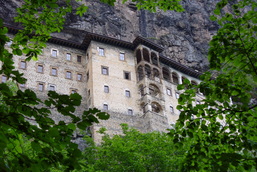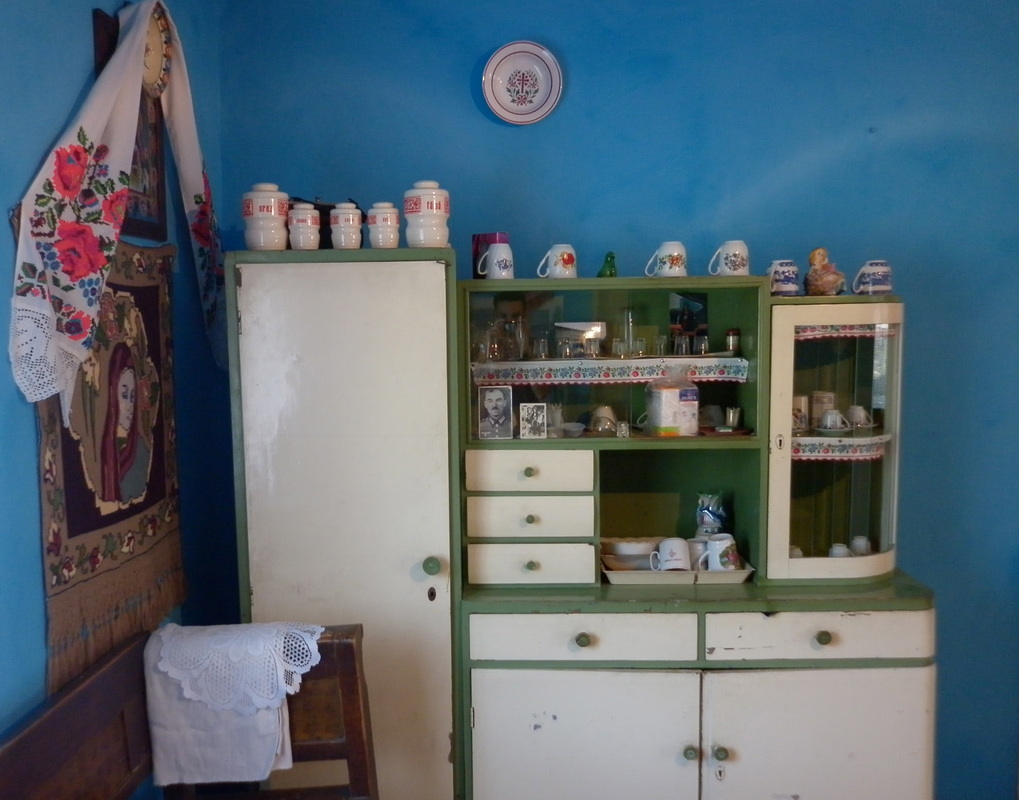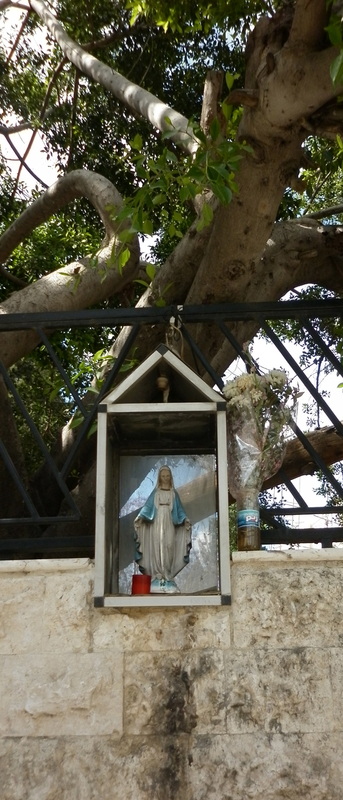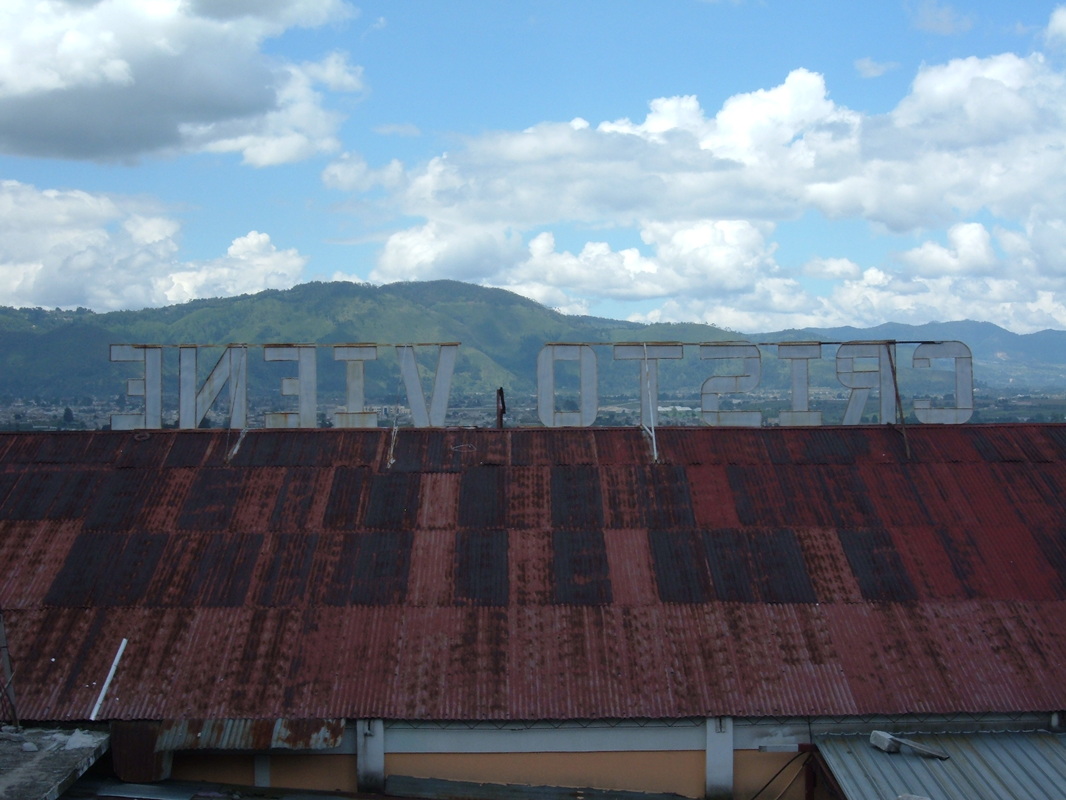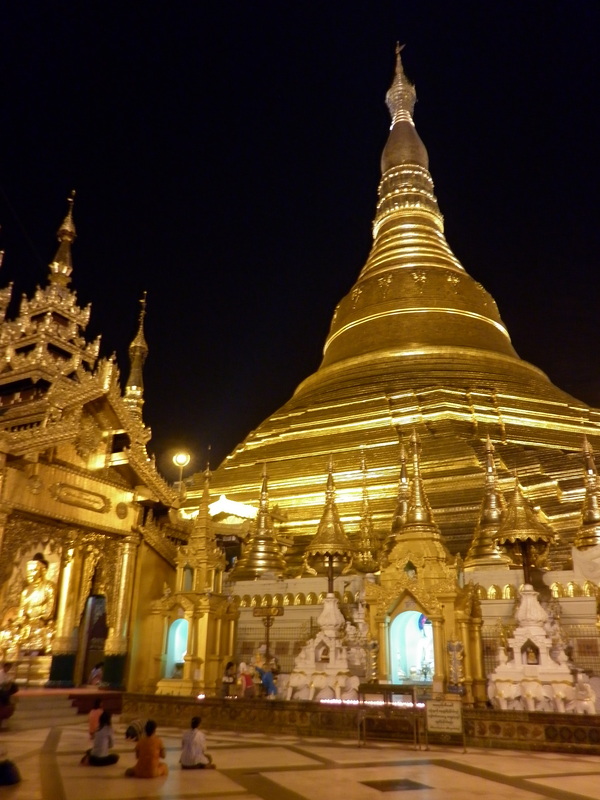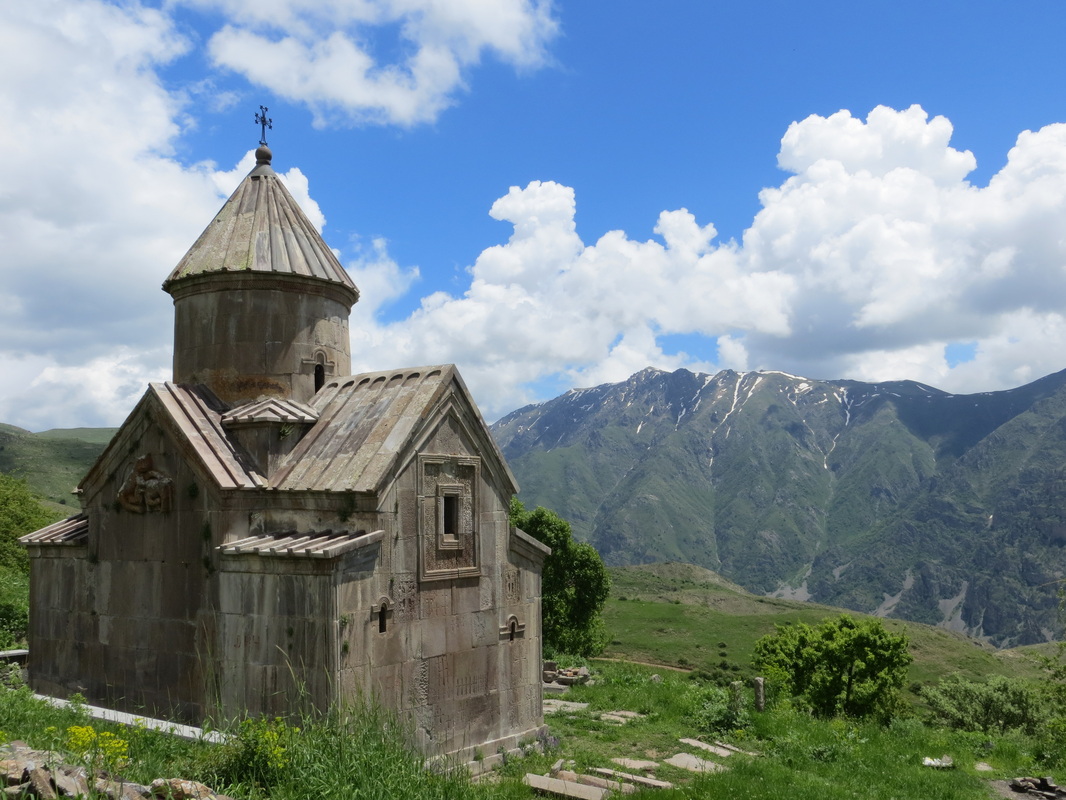|
Nothing tops Russia for beautiful churches. When we were there in 2005 a clear shift was taking place; although old people still held pro-Communist rallies in the streets, more and more churches were open and being renovated. For Easter, we attended mass in a traditional wooden church in Siberia. It was filled with candles and pine boughs, even the floor was covered. The scent of smoke and pine was phenomenal.
We were in Romania, Moldova and Transdniester in June 2011. Most churches are Orthodox, with some Catholics, however we also saw a fair number of German-style churches - some Catholic and some Protestant (courtesy of the Transylvania Saxons who have been in the area since the twelfth century). My favourite religious items were the hand-painted glass icons hanging in most rural homes. The photo below is from the kitchen of a rural farm house where we camped overnight when our hitchhiking luck ran out. It's impossible to stay friendless in Romania. Soon we were eating more bliny and drinking more vodka than we'd bargained for - lucky we had saints looking out for us.
Summer 2007 was all Turkey. We hiked, hitched, and ate phenomenal fruit. Turkey has some of the oldest Christian churches, including cave churches in Antakya (Antioch) said to have hidden St. Paul. One of my favourite memories was sleeping on the roof of a monastery outside the town of Mardin, near the Iraqi border. We woke up early and were the only audience members for the 6am Syrian Orthodox mass in Aramaic. The gestures, language, and chants were strikingly similar to traditional Jewish services.
|
|
|
I've been to the Middle East a few times over the last decade: Israel, Egypt, Jordan, Syria and Lebanon. Most of that travelling has been solo. I wish I had photos of the nighttime pilgrimage I made at St Catherine's Monastery in the Sinai. From the mountaintop it looked like a highway snaking through the desert but it isn't car headlights. It is hundreds of pilgrims trudging up, holding candles aloft.
With Jesse, I spent May 2011 in Lebanon. Although Our Lady of Lourdes, Francis, Anthony and Therese the Little Flower were everywhere in the north, I found quite a few new Maronite saints to learn about too. We slept one night at the monastery and shrine dedicated to Saint Charbel in the village of Bekaa Kafra (pictured) - a lifesaver since our hiking trail petered off and we were about to be stuck on a mountain with the sun was going down.... |
|
I had been looking forward to travelling in Ethiopia for a while, in large part because the country has one of the oldest national churches in the world, dating to the third or fourth century. We were there for Fasika - the month before Easter and then Easter celebrations. That meant excellent vegetarian options for a month
|
(apart from Muslim areas in the east) and then a massive goat slaughter. We celebrated with (new) friends: dorot as usual and an amazing goat dish. Too bad we had to hear the goat die next door...Ethiopians are also dead serious when they describe how the Queen of Sheba and King Soloman had an affair. The belief is that, through their son, the Ethiopians acquired the Ark of the Covenant, now housed at Axium. We were there for the week when they parade the Ark through the streets at dawn.
|
Cliff church in Tigray, Ethiopia. The boys pictured climb up the (steep!) mountain daily to learn Ga'ez, the ancient Semitic language of Ethiopian scriptures. Often this is the only reliable schooling for the boys (girls stay home), however that day the priest was a no-show. We waited with them for a couple hours and then checked out the board games and graffiti they had carved into the soft rock on the cliff face.
Below: Our friend Desda's sister's friend (yes, really) conducts an Easter coffee ceremony for us in Lalibela. |
|
The colorful saints and fiestas of the Philippines are a joy. We had an amazing time at an all-night Virgen fiesta in a Bohol Island village and a confusing time at the ruckus Santo Nino fiesta in Cebu City. Filipinos adore the Nino (in fact his first US shrine just opened in Tampa, FL. See photos here). It is believed that the small, wooden statue of the Sainted Child came to the island in the sixteenth century with the first Spanish explorers. It was lost but miraculously withstood destruction and was re-discovered once the Philippines was Christianized. Today the Nino is one of Filipinos' most favored intercessors. And he throws a good party too!
|
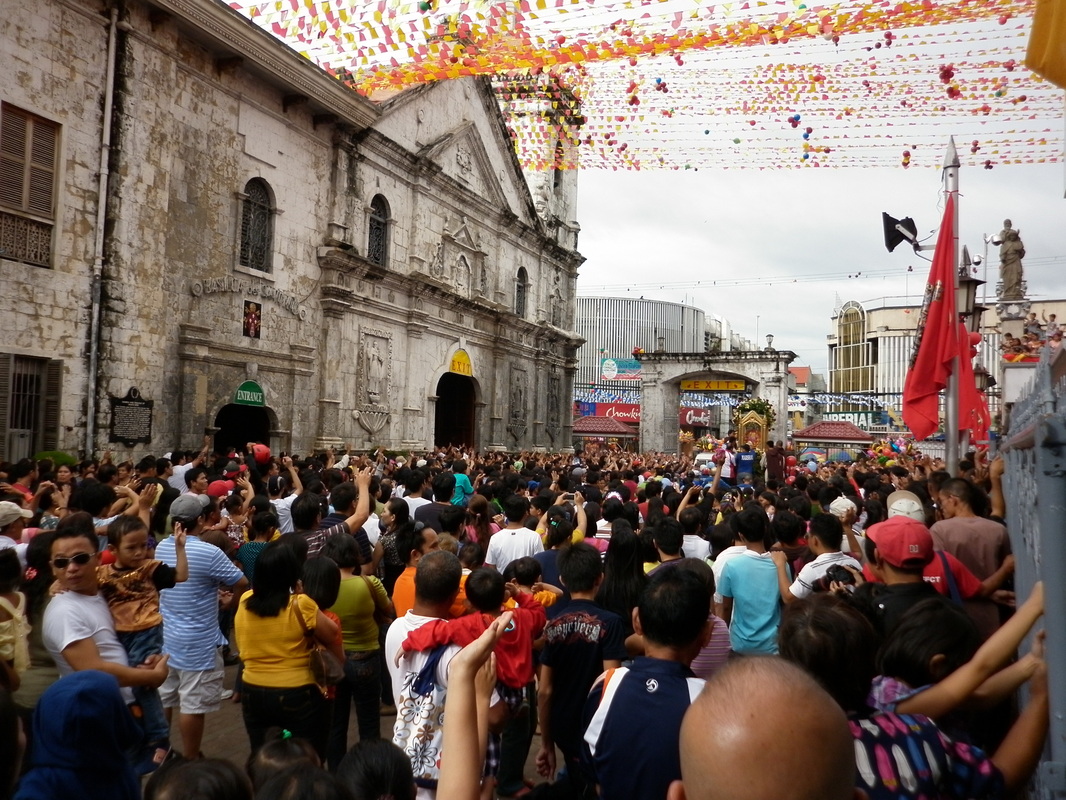
Waving goodbye to the Nino as he leaves the Cathedral square after mass (one of his replicas is being borne out but is barely visible in this photo). The crowd touches their handkerchiefs to him for blessings. Above: Sto. Nino statues for sale in the streets. A grandmother in the know helped me pick one out to buy.
I spent a summer during grad school in Guatamala, learning Spanish and travelling around, and we travelled through Nicaragua the following year. In both places, Catholic culture is vibrant but "evangelicos" (charismatic Protestants) are evident everywhere as well. Certainly, evangelical ties to (often) US-based churches is a helpful plus for many converts. But women in Guatemala and in Ethiopia also spoke to me about their conversions in pragmatic terms: it is a faith that's good for women. In Guatemala, I heard most often that women liked the strict prohibitions against drunkenness and adultery. In Ethiopia, Muslim women in particular described searching for a faith that valued women's literacy and was against arranged marriages.
|
I walked the Camino de Santiago along the "French" route in 2004. In 2009, I convinced Jesse to join me for a week along the Camino Norte. Those oh-so-necessary arrows indicating the route were rarely in evidence on the northern path. We definitely hiked up some hills only to come right back down again...
|
|
Christian-themed photos are harder to come by in Asia...so I've included a few stupas and Buddhas. Myanmar Buddhism was particularly vibrant, and is strongly promoted by the government. During our month there in 2011, we joined a full moon festival in the village of Kon Hut (near Namshan), waved to many a Nat shrine and joined the pilgrimage crowds at Mt Popa and the Golden Rock.
|
|
We were adopted by a group of monks at the Golden Rock who showed us around the vast mountain complex (which has lodgings, food, gambling, home-made remedies and even a video game area). In return, we posed for so many photos that we barely caught the last truck off the mountain. Whereas Myanmar pilgrims spend the night on the top, foreigners are forbidden. Close call...
Nat worship is ubiquitous in Myanmar. Most people described Nats as the spirits of the dead who can help or harm the living. Often they died tragically or suddenly. The monk below thought it was funny that I wanted a photo of his large Nat tattoo but he obliged. At right is a Nat house outside a village. Often they have tiny furniture and other niceties so the Nat can live comfortably. Coming in and out of villages, many Myanmar people wave a respectful hello to the Nats and then bow to the Buddhist temple. Below: a Nat at Mt. Popa (the largest Nat pilgrimage in Myanmar) accepts donations. Dancing with excitement the afternoon before the full moon festival in the mountain village of Kon Hut.
|
We were invited for a full moon party in the village of Kon Hut. As the sun set, the mountain people came into the village in their distinctive tribal dress. The festivities began with hours of tug-of -war (girls vs. boys). The men won, which seemed unfair to me since I was the only woman under 65 on our team without at least two babies strapped to her. Then the whole village dragged a 25-ft wood pyramid up to the Buddhist temple. In fact, mainly we women dragged it: "Sa! Sa! Sa!" we yelled in unison (presumably palaung for "pull, pull"?). Once there, the pyramid was torched and us girls danced around and around as it burned down.
|
Summer 2012 in Cambridge and Somerville, MA. The Portuguese family down the street from us is only one of many with a bathtub Madonna but theirs is a particularly impressive Fatima recreation. An angel flutters overhead while Lucia, Jacinta and Francisco kneel before Mary.
Back at home in Montreal and greeted by some new graffiti on the Cathedral down the street. Still working out some issues with religion in this province.
We travelled to Georgia and Armenia during the summer of 2013. Both countries have independent national churches that go back about 1700 years. Both also have beautiful stone monasteries, usually at the top of mountains. Above: the interior of Sameba in Tiblisi, the main Cathedral of the Georgian Orthodox Church.

Outside of the village of Yenokavank in northeast Armenia, we camped on a cliff next to a tiny chapel perched on the edge of the rock face. It was missing the roof and the altar was a large stone. We thought it was abandoned until a woman and her daughter arrived to pray. After they left, we noticed the icons, flowers and crosses wedged between the stones. The walls were covered with centuries-worth of soot and wax. At chapels, Armenians push thin, yellow candles against the wall to affix them while they burn.
In the morning, we woke to find group of sheep and goats. Biblical allusions side, it was unnerving. They were standing perfectly still, eyeing us silently.
In the morning, we woke to find group of sheep and goats. Biblical allusions side, it was unnerving. They were standing perfectly still, eyeing us silently.
 Toronto, Junction Triangle, November 2016
Toronto, Junction Triangle, November 2016







